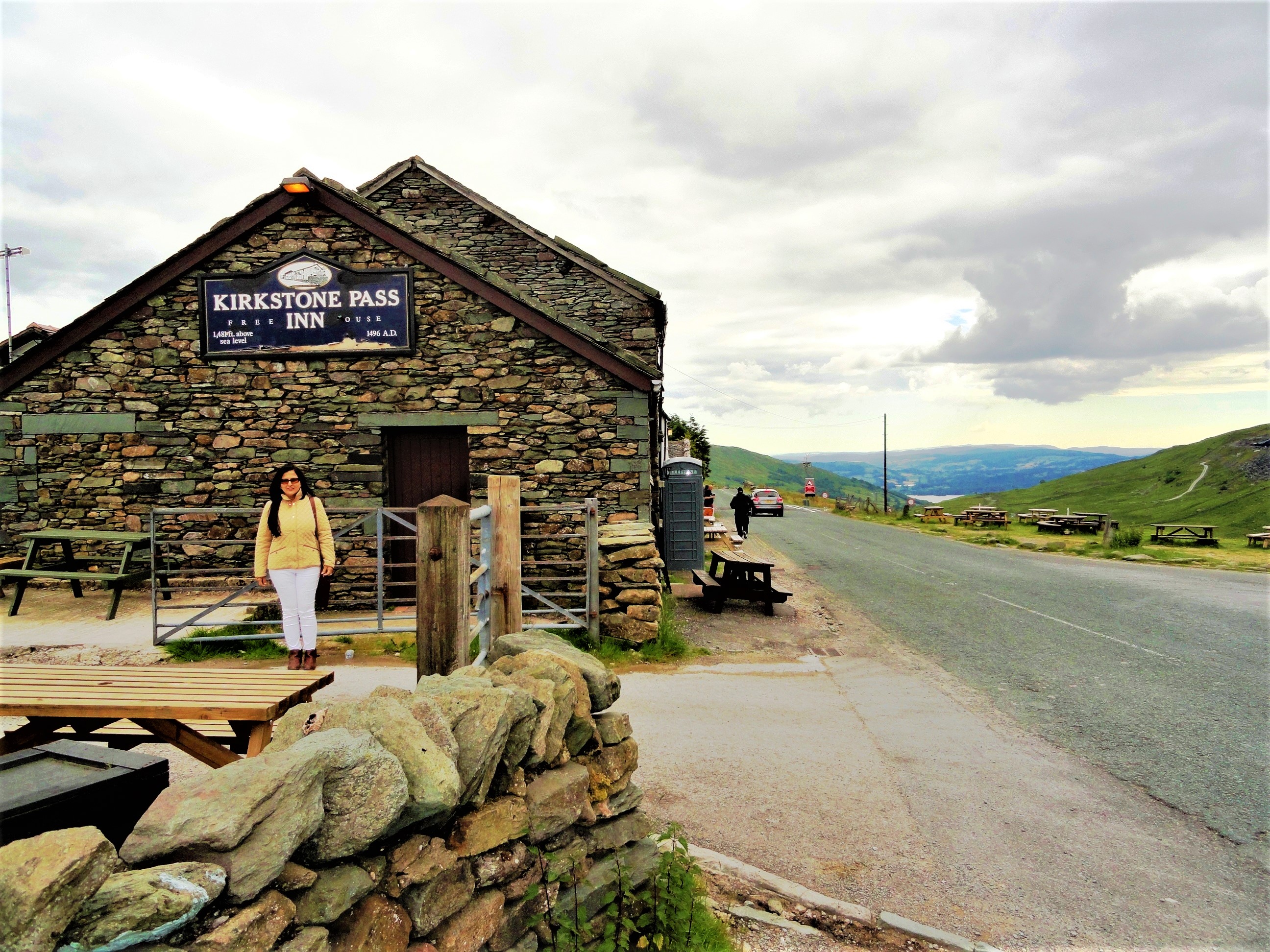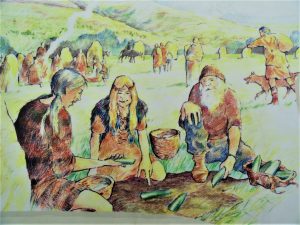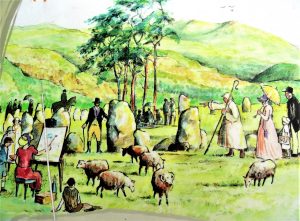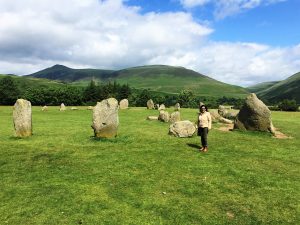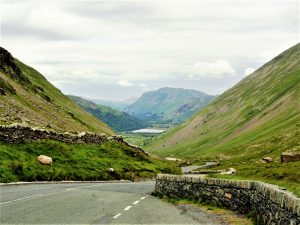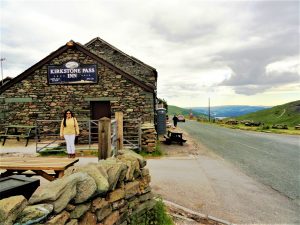Lakeland Secrets – Castlerigg Stone Circle to Kirkstone Pass
Awe inspiring and inexplicable….were the words that crossed my mind at the sight of the vast verdant plateau set in an amphitheatre of mountains in the far distance, a 360 degree view! I was at the 4500 year old Castlerigg Stone Circlein Keswick in Lake District of England – one the mysterious Stone Circles of England and oldest in Europe!! This accessible site continues to be the most visited tourist attraction even in contemporary times.
Castlerigg Stone Circle
We entered through the Lonscale-Fell entrance and walked towards the stunning Castlerigg Stone Circle, which comprised 40-41 Stones in all – large, irregular but oval, some as tall as 5 feet. Built in the Stone Age, I wondered what were these Stone circles for ? Looking at them I went back in time, visualizing Neolithic-man building it in the New Stone Age. Was it a venue for rituals and ceremonies, social gatherings or someplace built simply by the prehistoric farming communities who settled around the fertile regions fringing on the circular mountain ranges, for exchange of goods? Could this be a setting for dialogue, before the movement of people and animals to other grazing grounds? Possibly the Neolithic tools and axes discovered nearby were bought and sold here. An absolutely singular angle relates them to Aliens and landing ground for the UFO’s! My mind was wandering in all directions, pondering all possibilities!
Ambling towards the Stone – Circle, we noticed a rectangular enclosure inside the left side of the Stone Circle, referred to as the Sanctuary. It was a later addition to the original Castlerigg and could have been made for particular ceremonies or rituals. As we reached closer to the circle, we observed some chipped stones and soon discovered the reason- during the Victorian Era, visitors often flaked stones to take home as Souvenirs or good luck . It was due to the timely efforts of alert conservationalists that the Castlerigg Stone Circle was saved and announced a scheduled-ancient-monument, way back in 1882. Furthermore in 1913, it became the first protected archaeological site under the National Trust.
Astronomy at Castlerigg Stone Circle
Recent studies indicate that the Geometry used in the Stone-Circle and its Astronomical Alignments signify that their builders were proficient mathematicians and astronomers too! Then of course the Pagan connection cannot be completely ignored as the Stone Circle has a Solar Alignment and is used by the Druids for the Solstice celebration! Earlier, we were invited back during the Summer Solstice when the hotels offer breakfast at sunrise, followed by listening to Druid’s Solstice Ritual Music, a talk on the Castlerigg Stone Circle and understanding the meaning of the ritual vis-à-vis pagan.
The Discovery of Castlerigg Stone Circle
Previous to my visit, I had read that oodles of research pertaining to the isolated Castlerigg Stone circle had been undertaken since its rediscovery in the 18thcentury by antiquarian William Stukeley. Large part of the comprehension about Castlerigg came from the works of 18thand 19thcentury Antiquarians but prior to that, there are known to be writings about Castlerigg’s folklore and legends in the 16thcentury. Stukeley was one of the first to study Britain’s ancient sites and travelled through the country, recording his findings. Mysteriously, his observations also describe a second Stone Circle nearby, which is untraceable today! As I strolled around the Stone circle, I thought of Stukeley’s vital discovery, post which, thousands of tourists started to throng this place and continue to do so, initially with maps and guides and now with Google maps!
The Writers and Castlerigg Stone Circle
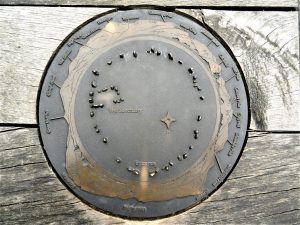
A Model of the Castlerigg Stone Circle Mountain Top with names of the mountain ranges on all four sides
Another vital information, which fascinated me was the names of important visitors I gathered to Castlerigg in 1799, these included – the celebrated poet William Wordsworth, his sister Dorothy Wordsworth and their friend –poet Samuel Taylor Coleridge! Later several 19thcentury writers used the dramatic Castlerigg in their books- describing Druids, Sacrifices and Rituals! No wonder so many writers refer them to as ‘Druidical Circle’. For thousands of years, the veiled past of the Stone Circle surrounded by a ring of mountains had certainly ignited the imagination of many before us and continues to do so!
Last of all, we walked towards the edge of the plateau of Stone circles and took a circular walk, admiring the amphitheatre effect. As we bade farewell to Castlerigg Stone Circle, I could not help but think of the enigma of mystic strange lights seen in the sky above the Stone circle before and recently! The Cumbrian mountain range held a total of 6 mysterious Stone-circle-arrangements!
Aira Force Waterfall and William Wordsworth
From the unexplained Castlerigg Stone Circle we set out for Aira Force Waterfall situated near the Ullswater Lake, ‘one of the most beautiful lake’ in England. We were disappointed to see that the 20 feet Aira Force waterfall, created by River Aira had dried up owing to scanty rain, that year. Nevertheless, we still wanted to have a look at it so we made up, by walking up to view the Lake Ullswater, into which a stream of the river falls. We also discovered that Aira has a special meaning in Old Norse language; ‘A’ was for river, ‘eyrr’ is ‘gravel bank’ and ‘fors’ is waterfall.
The most essential part of this stopover was that, I got an opportunity to be at the spot where the opening lines of William Wordsworth’s famous poem ‘Daffodils’, were compiled as he saw the Daffodils growing on the bank of Lake Ullswater where Aira confluences with the lake! Now, that makes the place poetically historic. Wordsworth often came here and Aira- Force waterfall is mentioned in 3 of his poems.
Kirkstone Pass and Inn
To culminate our day tour, we drove uphill for miles, on a wide winding road; bordered with grassy mountains, coming across a lone car here and there, before reaching the Kirkstone pass. We halted at the solitary black painted Kirkstone Pass Inn at the height of 1481 feet above sea level, the third highest Inn in England. We were at England’s Highest Mountain Pass open to motor traffic, apt for trekking enthusiasts and offering stunning views of landscape. Behind us, was the Rothay river valley from where we had approached and the Pass joined it to the Ambleside town. A few yards ahead of the Inn, we trekked towards the actual stone termed as ‘Kirkstone’ from which the area takes its name. The silhouette of the stone is similar to a Church steeple or tower as in Old Norse language ‘Kirk’ literally means a Church!
Later, back at the Inn we went in, to see the interiors of the Inn that has been here since 1496 AD! Nestled in the Lakeland Mountains, Kirkstone-Pass Inn presented us a chance to relax at a medieval location. The low beam ceiling, the open log fire inside along with the traditional food was welcoming after the long taxing drive, but we were surprised to see South Indian non-vegetarian meal menu too!! While chatting with the staff we discovered that this area had been a main Slatestone Quarry site for many years as it has volcanic material deposits, layered 450 million years ago! Also, lead and copper were mined here. We decided to wind up our day by visiting the top of the Kirkstone Pass from where the Stone quarry could be seen.
Back at the guest house, we chatted with Richard who runs it, narrating him our excursion. A part of the conversation that I recollect till today is that he anxiously queried –‘Why did you go to Kirkstone-Pass, there are ghosts there” and I replied that we saw none, so it was alright!
- Visitors at Castlerigg Stone Circle in Victorian Era
- Stone age market at prehistoric Castlerigg
- A Model of the Castlerigg Stone Circle Mountain Top with names of the mountain ranges on all four sides
- Kirkstone Pass
- Kirkstone Pass Inn
- Writer at Castlerigg Stone Circle
